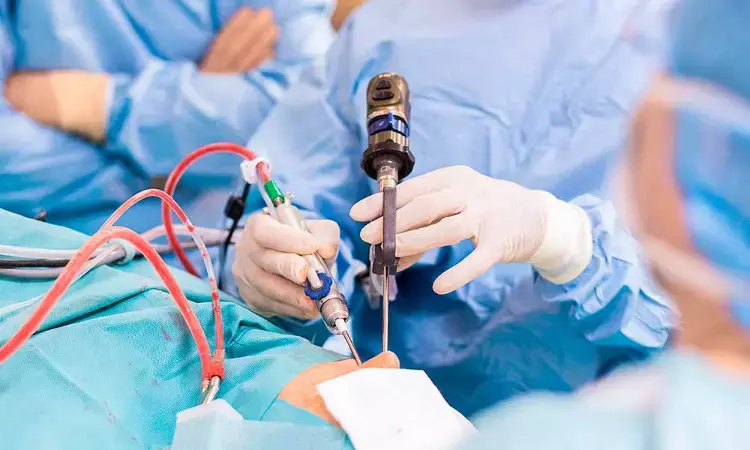- Home
- Medical news & Guidelines
- Anesthesiology
- Cardiology and CTVS
- Critical Care
- Dentistry
- Dermatology
- Diabetes and Endocrinology
- ENT
- Gastroenterology
- Medicine
- Nephrology
- Neurology
- Obstretics-Gynaecology
- Oncology
- Ophthalmology
- Orthopaedics
- Pediatrics-Neonatology
- Psychiatry
- Pulmonology
- Radiology
- Surgery
- Urology
- Laboratory Medicine
- Diet
- Nursing
- Paramedical
- Physiotherapy
- Health news
- Fact Check
- Bone Health Fact Check
- Brain Health Fact Check
- Cancer Related Fact Check
- Child Care Fact Check
- Dental and oral health fact check
- Diabetes and metabolic health fact check
- Diet and Nutrition Fact Check
- Eye and ENT Care Fact Check
- Fitness fact check
- Gut health fact check
- Heart health fact check
- Kidney health fact check
- Medical education fact check
- Men's health fact check
- Respiratory fact check
- Skin and hair care fact check
- Vaccine and Immunization fact check
- Women's health fact check
- AYUSH
- State News
- Andaman and Nicobar Islands
- Andhra Pradesh
- Arunachal Pradesh
- Assam
- Bihar
- Chandigarh
- Chattisgarh
- Dadra and Nagar Haveli
- Daman and Diu
- Delhi
- Goa
- Gujarat
- Haryana
- Himachal Pradesh
- Jammu & Kashmir
- Jharkhand
- Karnataka
- Kerala
- Ladakh
- Lakshadweep
- Madhya Pradesh
- Maharashtra
- Manipur
- Meghalaya
- Mizoram
- Nagaland
- Odisha
- Puducherry
- Punjab
- Rajasthan
- Sikkim
- Tamil Nadu
- Telangana
- Tripura
- Uttar Pradesh
- Uttrakhand
- West Bengal
- Medical Education
- Industry
Endotracheal tube versus reinforced laryngeal mask- which is better for endoscopic sinus surgery?

Recently published study provides valuable insights into the effectiveness of RLMA as an alternative airway technique for sinus surgery and suggests potential benefits such as reduced anesthesia duration and postoperative adverse events, contributing to the understanding of the impact of different airway techniques on emergence characteristics in sinus surgery.
The study compared the use of reinforced laryngeal mask airway (RLMA) versus an endotracheal tube (ETT) with a throat pack during elective sinus surgery. The researchers conducted a randomized controlled trial of 72 patients and measured the primary outcome of emergence time and secondary outcomes including time to removal of airway device, remifentanil use, procedure times, mean arterial pressure (MAP), and postoperative adverse events.
Comparison of RLMA and ETT for Sinus Surgery
The study found that there was no significant difference in emergence time between the ETT and RLMA groups. However, remifentanil use was significantly higher in the ETT group, and the ETT group showed a significantly increased total anaesthetic time. Mean arterial pressure (MAP) did not show significant differences between the two groups. The reinforced laryngeal mask airway (RLMA) had lower rates of postoperative adverse events, such as cough and throat pain.
Findings and Outcomes
The findings indicate that RLMA was comparable to ETT in terms of emergence time, with lower remifentanil use, anaesthesia duration, and fewer postoperative adverse events. The study also highlighted the potential advantages of RLMA, including smoother emergence from anaesthesia and decreased upper airway stimulation. The RLMA group also required less rescue dosing with fentanyl or metaraminol, suggesting improved ease of maintaining a stable anaesthetic.
In conclusion, the study demonstrated that using RLMA for endoscopic sinonasal surgery was comparable to ETT in terms of emergence time, remifentanil use, and adverse events such as sore throat. The study provides valuable insights into the effectiveness of RLMA as an alternative airway technique for sinus surgery and suggests potential benefits such as reduced anaesthesia duration and postoperative adverse events. The findings contribute to the understanding of the impact of different airway techniques on emergence characteristics in sinus surgery.
Key Points -
- A randomized controlled trial compared the use of reinforced laryngeal mask airway (RLMA) versus an endotracheal tube (ETT) with a throat pack during elective sinus surgery among 72 patients.
- The study found no significant difference in emergence time between the ETT and RLMA groups, but remifentanil use was significantly higher in the ETT group, and the ETT group showed a significantly increased total anaesthetic time. RLMA had lower rates of postoperative adverse events, such as cough and throat pain.
- The findings indicate that RLMA was comparable to ETT in terms of emergence time, with lower remifentanil use, anaesthesia duration, and fewer postoperative adverse events. The study suggests potential benefits of RLMA, including smoother emergence from anaesthesia and decreased upper airway stimulation.
Reference –
Raokadam, Vasanth; Thiruvenkatarajan, Venkatesan; Bouras, George S.; Zhang, Alex1; Psaltis, Alkis. Emergence characteristics comparing endotracheal tube to reinforced laryngeal mask airway during endoscopic sinus surgery – A randomised controlled study. Indian Journal of Anaesthesia 68(5):p 460-466, May 2024. | DOI: 10.4103/ija.ija_966_23.
MBBS, MD (Anaesthesiology), FNB (Cardiac Anaesthesiology)
Dr Monish Raut is a practicing Cardiac Anesthesiologist. He completed his MBBS at Government Medical College, Nagpur, and pursued his MD in Anesthesiology at BJ Medical College, Pune. Further specializing in Cardiac Anesthesiology, Dr Raut earned his FNB in Cardiac Anesthesiology from Sir Ganga Ram Hospital, Delhi.


